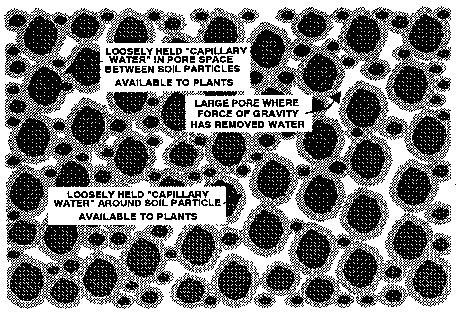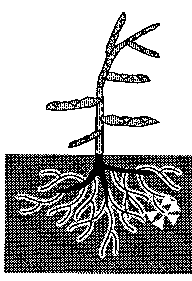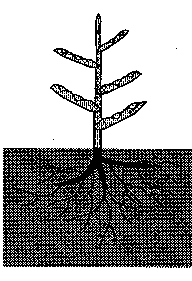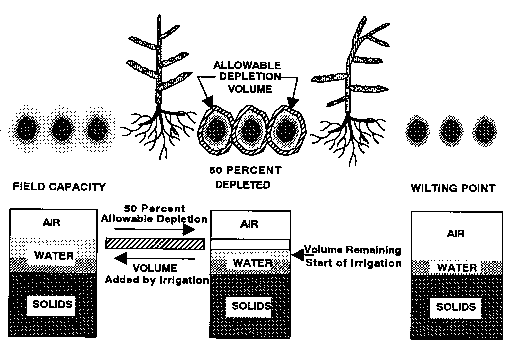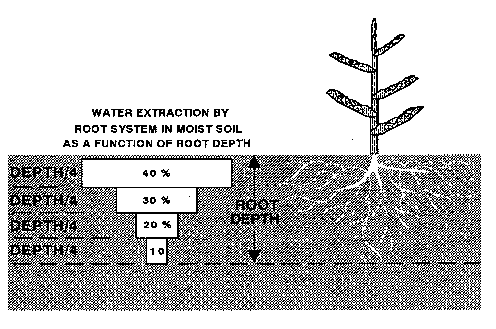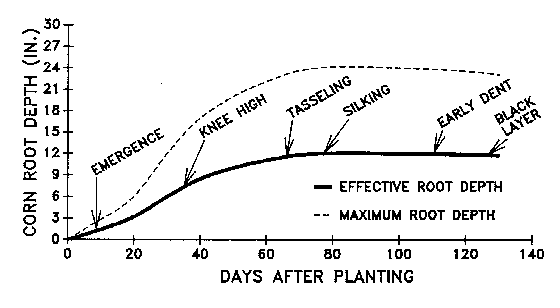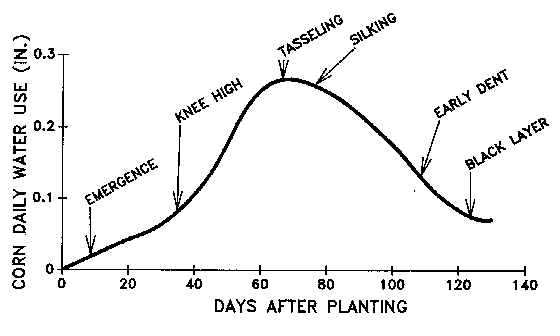Introduction
Many crops in North Carolina are irrigated over a wide range of soil conditions and crop production practices. Effectively irrigating a specific crop in a specific soil requires the development of a good irrigation schedule.
Irrigation scheduling is simply knowing when to irrigate and how much irrigatzon water to apply. An effective irrigation schedule helps to maximize profit while minimizing water and energy use. The following factors contribute to developing a workable and efficient irrigation schedule:
- soil properties
- soil-water relationships
- type of crop and its sensitivity to drought stress
- stage of crop development
- availability of a water supply
- climatic factors such as rainfall and temperature.
This publication presents basic information on the first four factors-on veil, water, and plant relationships to be considered in developing an effective irrigation schedule. Terms used in this publication are summarized in the box below.
Soil-Water Relationships
The soil is composed of three major parts: air, water, and solids (Figure 1). The solid component forms the framework of the soil and consists of mineral and organic matter. The mineral fraction is made up of sand, silt, and clay particles. The proportion of the soil occupied by water and air is referred to as the pore volume. The pore volume is generally constant for a given soil layer but may be altered by tillage and compaction. The ratio of air to water stored in the pores changes as water is added to or lost from the soil. Water is added by rainfall or irrigation, as shown in Figure 2. Water is lost through surface runoff, evaporation (direct loss from the soil to the atmosphere), transpiration (losses from plant tissue), and either percolation (seepage into lower layers) or drainage.
The pore volume is actually a reservoir for holding water. Not all of the water in the reservoir is available for plant use. Figure 3 represents a "wet" (saturated) soil immediately after a large rainfall. Note that all of the pores are filled with water. Gravity will pull some of this water down through the soil below the crop's root zone. The water that is redistributed below the root zone due to the force of gravity is gravitational water. In general, gravitational water is not available to plants, especially in sandy soils, because the redistribution process occurs quickly (in two days or less).
| Term | Definition |
| Saturation | Condition when all soil pores are filled with water. |
| Field Capacity (FC) | The soil-water content after the force of gravity has drained or removed all the water it can, usually 1 to 3 days after rainfall. |
| Gravitational Water | Water in the soil that is free to drain or move due to the forces of gravity. Gravitation water is the volume of water in the soil between saturation and field capacity. This water is not usually used by plants. |
| Redistribution (Percolation) | Downward movement of gravitational water through the soil profile. |
| Capillary Water | Water retained in soil pores after gravitational water has drained or is held loosely around soil particles by surface tension. Most of the soil-water available to plants is capillary water. |
| Temporary Wilting | Daily cycle of plant wilting during the day followed by recovery at night. |
| Permanent Wilting Point (PWP) | The soil-water content of which healthy plants can no longer extract water from the soil at a rate fast enough to recover from wilting. The permanent wilting point is considered the lower limit of plant-available water. |
| Plant-Available Water (PAW) | The amount of water held in the soil that is available to plants; the difference between field capacity and permanent wilting point. |
| Unavailable Water | Water in thin, tightly held films around soil particles; not available to plants. |
| Potential Rooting Depth | The deepest rooting depth attained by crop roots depending on the type of crop and independent of soil conditions. |
| Maximum Rooting Depth | Deepest rooting depth attained by a crop under specific soil conditions. Physical and chemical barriers in the soil often limit actual rooting depths to less than potential rooting depth. |
| Effective Root Depth | The upper portion of the root zone where plants get most of their water. Effective root depth is estimated as one-half the maximum rooting depth. |
| Potential Evapotranspiration (PET) | Maximum amount of water that could be lost through evapotranspiration under a given set of atmospheric conditions, assuming that the crop covers the entire soil surface and that the amount of water present in the soil does not limit the process. |
| Crop Water Use Rate | Maximum daily rate at which a crop can extract water from a moist soil to satisfy PET; controlled ny stage of crop development. |
| Crop Susceptibility | A measurement of crop response to a unit of stress. |
| Depletion Volume | The amount of plant-available water removed from the soil by plants and evaporation from the soil surface. |
| Allowable Depletion Volume | The amount of plant-available water that can be removed from the soil without seriously affecting plant growth and development. |
After the redistribution process is complete, the soil is at field capacity. Under this condition it contains the greatest amount of water that is potentially available to plants. The actual volume of water present when the soil is at field capacity depends on the soil texture. Procedures for estimating field capacity are discussed in Extension Publication AG452-2, Measuring Soil Water for Irrigation Scheduling: Monitoring Methods and Devices.
Plants get most of their water from capillary water. This is the water retained in soil pores after gravitational water has drained. Surface tension (suction) holds capillary water around the soil particles, as shown in Figure 4. As water is removed by plants or by evaporation from the soil surface, the films of water remaining around the soil particles become thinner and are held by the soil particles more tightly.
When the surface tension becomes high, the plant is unable to take up any of the remaining water and permanent wilting results. When the plant has removed all available water, the soil's water content has reached the permanent wilting point (PWP), as shown in Figure 5.
Plant-available water, PAW, is the volume of water stored in the soil reservoir that can be used by plants. It is the difference between the volume of water stored when the soil is at field capacity and the volume still remaining when the soil reaches the permanent wilting point (the lower limit), as shown in Figure 6.
The amount of PAW stored in the soil reservoir is commonly expressed as the depth of water per unit depth of soil. Typical units are inches of PAW per inch of soil depth or inches of PAW per foot of soil depth. Different types of soils have different PAWs. Estimates of PAW for various soil textural classes are given in published soil survey reports. These estimates range from less than 0.05 inch of PAW per inch of soil for coarse sandy soils to nearly 0.2 inch of PAW per inch of soil for silty loams (Table 1).
Soil properties including PAW vary within a field and from field to field even within the same soil series. As a result, values given in soil surveys are averages and are not a good estimate for a specific field.
| Textural Class | Plant-Available Water (inches of water per inch of soil) |
| Coarse sand and gravel | 0.02 – 0.05 |
| Sand | 0.05 – 0.11 |
| Loamy sand | 0.09 – 0.15 |
| Sandy loam | 0.11 – 0.15 |
| Loams | 0.11 – 0.17 |
| Silt loam | 0.11 – 0.18 |
| Silty clay loam | 0.11 – 0.15 |
| Clay loam | 0.09 – 0.16 |
| Sandy clay loam | 0.09 – 0.15 |
| Silty clay | 0.10 – 0.16 |
| Clay | 0.10 – 0.16 |
Soil-Water and Plant Stress
As a plant extracts water from the soil, the amount of PAW remaining in the soil decreases. The amount of PAW removed since the last irrigation or rainfall is thedepletion volume. Irrigation scheduling decisions are often based on the assumption that crop yield or quality will not be reduced as long as the amount of water used by the crop does not exceed the allowable depletion volume.
The allowable depletion of PAW depends on the soil and the crop. For example, consider corn growing in a sandy loam soil three days after a soaking rain. Even though enough PAW may be available for good plant growth, the plant may wilt during the day when potential evapotranspiration (PET) is high. Evapotranspiration is the process by which water is lost from the soil to the atmosphere by evaporation from the soil surface and by the transpiration process of plants growing in the soil. Potential evapotranspiration is the maximum amount of water that could be lost through this process under a given set of atmospheric conditions, assuming that the crop covers the entire soil surface and that the amount of water present in the soil does not limit the process.
Potential evapotranspiration is controlled by atmospheric conditions and is higher during the day. Plants must extract water from the soil that is next to the roots. As the zone around the root begins to dry, water must move through the soil toward the root (Figure 7). Daytime wilting occurs because PET is high and the plant takes up water faster than the water can be replaced.
At night when PET decreases to near zero, water steadily moves from the wetter soil to the drier zone around the roots. The plant recovers turgor and wilting ceases (Figure 8). This process of wilting during the day and recovering at night is referred to as temporary wilting. Proper irrigation scheduling reduces the length of time a crop is temporarily wilted.
Most crops will recover overnight from temporary wilting if less than 50 percent of the PAW has been depleted. Therefore, the allowable depletion volume generally recommended in North Carolina is 50 percent (Figure 9). However, the recommended volume may range from 40 percent or less in sandy soils to greater than 60 percent in clayey soils. The allowable depletion is also dependent on the type of crop, its stage of development, and its sensitivity to drought stress. For example, the allowable depletion recommended for some drought-sensitive crops (vegetable crops in particular) is only 20 percent during critical stages of development. The allowable depletion may approach 70 percent during noncritical periods for drought-tolerant crops such as soybeans or cotton.
Plant Factors
Three plant factors must be considered in developing a sound irrigation schedule: the crop's effective root depth, its moisture use rate, and its sensitivity to drought stress (that is, the amount that crop yield or quality is reduced by drought stress).
Effective Root Depth
Rooting depth is the depth of the soil reservoir that the plant can reach to get PAW. Crop roots do not extract water uniformly from the entire root zone. Thus,the effective root depth is that portion of the root zone where the crop extracts the majority of its water. Effective root depth is determined by both crop and soil properties.
Plant Influence on Effective Root Depth. Different species of plants have different potential rooting depths. The potential rooting depth is the maximum rooting depth of a crop when grown in a moist soil with no barriers or restrictions that inhibit root elongation. Potential rooting depths of most agricultural crops important in North Carolina range from about 2 to 5 feet. For example, the potential rooting depth of corn is about 4 feet.
Water uptake by a specific crop is closely related to its root distribution in the soil. About 70 percent of a plant's roots are found in the upper half of the crop's maximum rooting depth. Deeper roots can extract moisture to keep the plant alive, but they do not extract sufficient water to maintain optimum growth. When adequate moisture is present, water uptake by the crop is about the same as its root distribution. Thus, about 70 percent of the water used by the crop comes from the upper half of the root zone (Figure 10). This zone is the effective root depth.
Soil Influence on Effective Root Depth. The maximum rooting depth of crops in North Carolina is usually less than their potential rooting depth and is restricted by soil chemical or physical barriers. North Carolina subsoils have a pH of about 4.5 to 5.0, which presents a chemical barrier to root growth, as shown in Figure 11. Liming practices rarely improve soil pH below the 2-foot depth. Shallow soils (Carolina slate belt soils) or soils with compacted tillage pans (coastal plain soils) are examples of soils with physical barriers that restrict root penetration below the plow depth (usually less than 12 inches unless subsoiling is practiced). Thus, for example, while corn has a potential rooting depth of 4 feet, when grown under North Carolina conditions, its maximum rooting depth is about 2 feet. Maximum rooting depths for several crops under North Carolina conditions are given in Table 2.
The effective root depth is the depth that should be used to compute the volume of PAW in the soil reservoir. The effective root depth for a mature root zone is estimated to be one-half the maximum rooting depth listed in Table 2. For example, under North Carolina conditions corn has a maximum rooting depth of 2 feet; thus, the maximum effective root depth is estimated to be 1 foot. Effective root depth is further influenced by the stage of crop development. Effective root depths for most crops increases as top growth increases until the reproductive stage is reached. After this time, effective root depth remains fairly constant. Maximum rooting depth and effective rooting depth as a function of corn development are shown in Figure 12.
| 12 | 18 |
| Flowers | Field peas |
| Strawberries | Potatoes |
| Kale | Tobacco |
| Lettuce | Beans |
| Mustard | Beets |
| Spinach | Broccoli |
| Onions | Cabbage |
| Peppers | Cauliflower |
| Carrots | |
| 24 | Collards |
| Peanuts | Peppers |
| Field corn | Turnips |
| Soybeans | Rutabegas |
| Asparagus | Cucumbers |
| Cantaloupes | Tomatoes |
| Sweet corn | |
| Eggplant | 30 |
| Okra | Alfalfa |
| Watermelons | Cotton |
Crop Water Use Rate
Often, irrigation scheduling requires an estimate of the rate at which PAW is being extracted. A "checkbook" approach is often used to keep a daily accounting of water additions and removal. Traveling irrigation systems usually require several days to complete one irrigation cycle. Soil-water measurements should be used to schedule irrigation for these systems, but continued PAW extraction during the irrigation cycle must also be estimated so that the last part of the field does not get too dry.
In the above situations, the crop's water use rate must be estimated. Estimates of the water use rate for most crops are available from county Extension Service or Soil Conservation Service offices. As with rooting depth, water use rate is a function of the crop's stage of development, as shown in Figure 13. For example, corn uses water three times as fast during the pollination period (65 to 75 days after planting, 0.25 inch per day) as during the knee-high stage (35 to 40 days after planting, 0.08 inch per day).
Crop Sensitivity to Drought Stress
The reduction in crop yield or quality resulting from drought stress depends on the stage of crop development. For example, corn is most susceptible to stresses caused by dry conditions at the silking stage (Figure 14). For a given level of stress, the yield reduction for corn would be four times greater at the silking stage than at the knee-high stage. From the yield standpoint, applying irrigation water at silking would be worth four times more than if the same amount of water was applied during the knee-high stage. Knowledge of this relationship is most useful when the irrigation capacity or water supply is limited. When water is in short supply, irrigation should be delayed or cancelled during the least susceptible crop growth stages. This water can then be reserved for use during more sensitive growth stages.
The susceptibility of corn to dry stress at various stages of development is shown in Figure 14. This relationship is typical for most agricultural crops irrigated in North Carolina. The most critical irrigation period typically begins just before the reproductive stage and lasts about 30 to 40 days to the end of the fruit enlargement or grain development stage. Because the root system is fully developed by the beginning of the reproductive period, irrigation amounts should be computed to replace the depleted PAW within the effective root zone (12 inches). Exceptions include tobacco and other transplanted crops where irrigation is often scheduled immediately after transplanting to ensure stand establishment.
When irrigation is scheduled before the crop root system is fully developed, the amount of irrigation to apply should be based on the depleted PAW within the actual effective root depth at the time of irrigation. For example, irrigation scheduled when corn is at the knee-high stage (35 to 40 days after planting) should apply only about two-thirds as much water as an irrigation scheduled during the tasseling stage (65 days after planting) because the effective rooting depth at the knee-high stage is only two-thirds as deep (8 inches compared to 12 inches), as shown in Figure 12. For soils that have an abrupt textural change within the effective root depth, such as a loamy sand surface texture overlying a sandy clay loam, a correction may be necessary to account for the different amounts of PAW within each soil texture. For example calculations of irrigation amounts, refer to Extension Publication AG-452-4, Irrigation Scheduling to Improve Water and Energy Use Efficiencies.
Technical Assistance
Basic knowledge of soil, water and plant relationships is important for effective irrigation scheduling. Your county Agricultural Extension and Soil Conservation Service offices are available to help with irrigation decisions. Their staff members are familiar with soil, water, and plant relationships and have received training on the proper interpretation of specific soil and crop properties important to irrigation scheduling.
Publication date: June 1, 1996
AG-452-01
N.C. Cooperative Extension prohibits discrimination and harassment regardless of age, color, disability, family and marital status, gender identity, national origin, political beliefs, race, religion, sex (including pregnancy), sexual orientation and veteran status.




